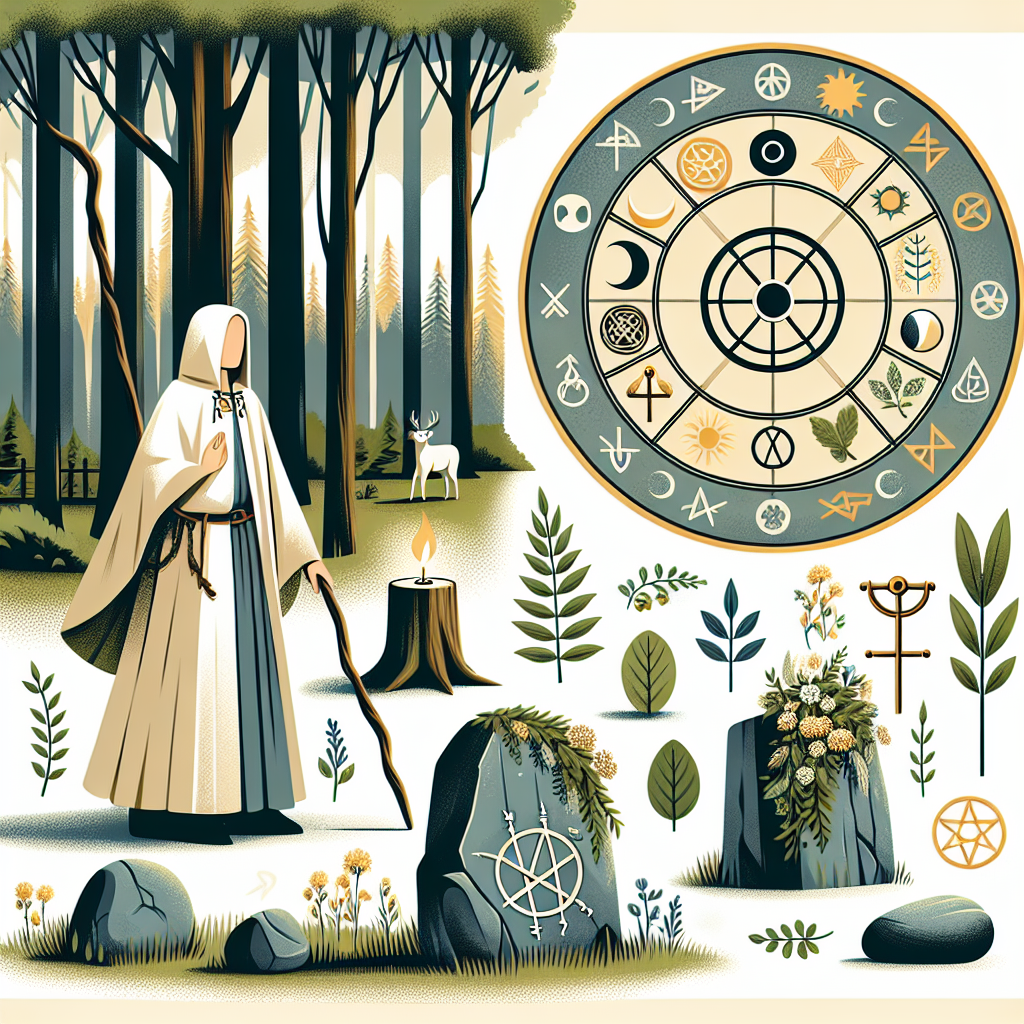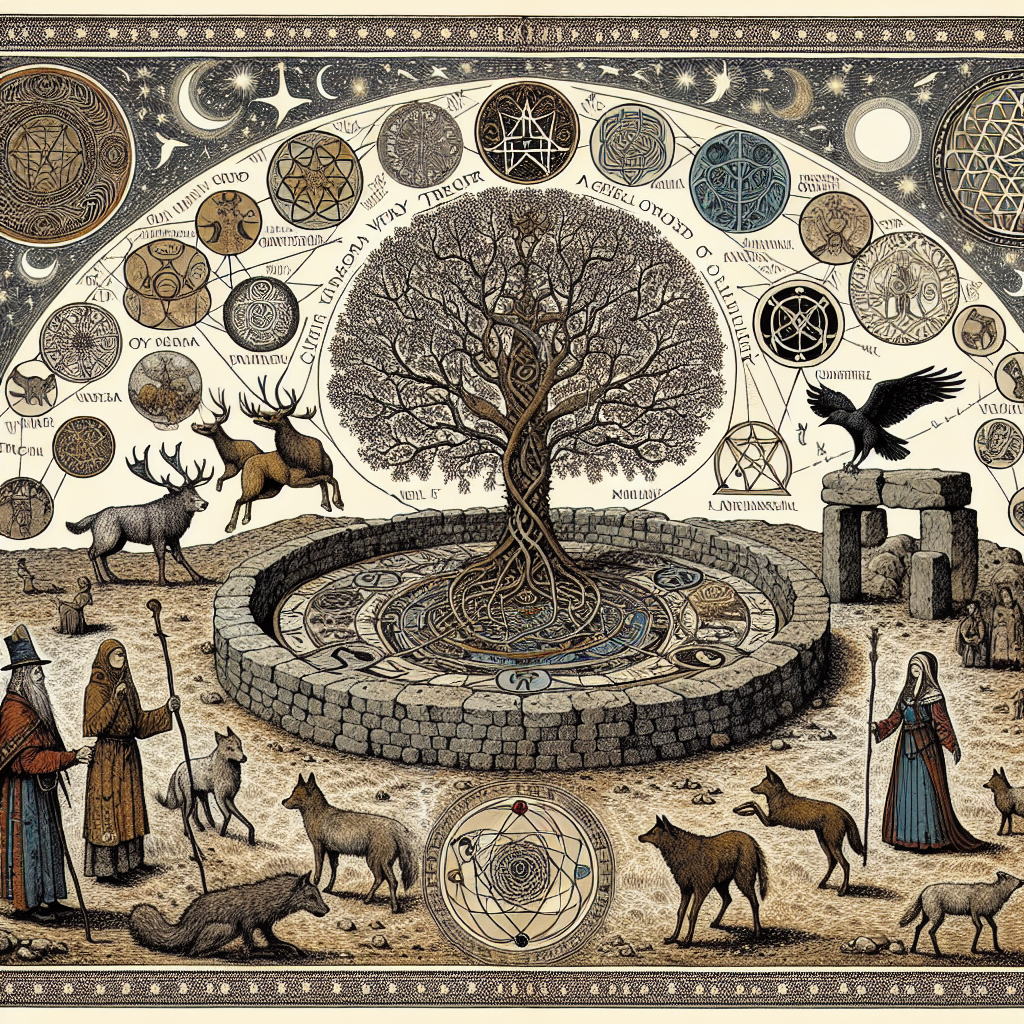As an Amazon Associate I earn from qualifying purchases.
↻
Last updated: December 24, 2025

Paganism, usually referred to as a panorama of diverse contemporary religions that draw on ancient practices outside the world's main religious cultures, is currently practiced by approximately a million people in the United States alone. While it is inclusive of several spiritual path variations, the unifying theme arises from focusing on the earth and nature, as well as the reverence of ancient gods and goddesses. The term “pagan” itself originates from the Latin word “paganus,” which initially meant “country dweller” or “rustic,” and was later used pejoratively by early Christians to refer to non-Christians.
Understanding Pagan beliefs requires a dive into history, when Paganism was the dominant religious practice before the rise of monotheistic religions; particularly Christianity in the western world. In many ways, contemporary paganism is a resurgence of these ancient religions, adapted to the modern world. This revival, sometimes referred to as Neo-Paganism, began in the 20th century and has gained more adherence in the early 21st century. Current practitioners of Paganism often draw their beliefs and practices from different old pagan religions; these may include pre-Christian European religions, or sometimes those from Egypt, Greece, Rome, as well as other ancient civilizations spread across the globe.
This resurgence is perhaps influenced by the desire of its adherents to reconnect with nature, and shun the seemingly over-rationalized modern society that often neglects the spiritual dimension of human existence. It's also observed that Paganism's flexibility, where there is no necessary dogma or universal set of beliefs, is attractive to those who seek spiritualism without the constraint of rigid religious rules.
Statistically, Paganism has seen significant growth in recent years. According to the Pew Research Center, the number of people who identified as Wiccan or Pagan in the United States was an estimated 730,000 in 2014, a clear increase from previous years. Concurrently, this rise in interest in Paganism has led to a proliferation of publications, and online platforms that discuss Pagan beliefs. This shows that in the shifting landscape of contemporary religious practices, Paganism plays a notable, if not prominently visible role.
A unique aspect about Paganism that resonates with many adherents is the concept of “polytheism,” or the belief in multiple gods and goddesses. Unlike monotheistic religions, Pagans see divinity manifested in multiple deities, each with their own domains and expertise. Earth, air, fire, water, and spirit are often revered as elemental divinities. The “Goddess” and the “Horned God” feature prominently in many branches of Paganism, symbolizing the partnership and balance between the feminine and the masculine. For many, Paganism provides a spiritual solution that embodies respect for nature, gender equality, and a compelling, multitudinous universe of deities.
Paganism also encourages individual spiritual experiences, with no strict scriptures or universal regulations. Personal religious experiences, such as meditation, dream work, divination, personal rituals, and communion with nature, play an important role in a Pagan's spiritual practice. Thus, Paganism recognizes the individual's capacity for personal spiritual development and insight. This individualistic element of Paganism makes it very different from most other religions, which more often emphasize communal worship and adherence to specific, prescribed practices and beliefs.
What are the Modern Understandings of Pagan Beliefs?
Pagan beliefs entail a distinct and broad variety of contemporary religious practices that derive from ancient, often pre-Christian and pre-Judaic indigenous cultures. These beliefs revolve around the honor and worship of multiple deities (pagan gods and goddesses), reverence for nature, celebration of seasonal cycles, and the use of magic and ritual for personal growth and community bonding. These beliefs, along with their diverse rituals and traditions, are attracting a resurgence of interest in today's world for their emphasis on tolerance, humanistic values, and environmental stewardship. The following sections will delve deeper into the practices, principles, and relevance of pagan beliefs in a modern context.
Defining Pagan Beliefs
Pagan beliefs, which span various cultures and periods, are generally characterized by a profound reverence for nature and the divinities representing its diverse aspects. In our modern times, paganism can be seen as an umbrella term encompassing several spiritual paths (like Wicca, Druidry, and Shamanism) that are not part of the mainstream, monotheistic religions. In general, these paths share some significant characteristics, including a cyclic worldview, pantheistic or polytheistic divine concepts, and deep ecological concern.
Concept of Deity in Pagan Beliefs
In most pagan belief systems, deities are perceived as part of nature rather than apart from it. These systems are either pantheistic, where divinity is perceived as immanent in nature, or polytheistic, where multiple gods and goddesses are worshiped. The concept of the goddess is particularly inherent in pagan beliefs, be it in a traditional Triple Goddess archetype (often perceived as the Maiden, the Mother, and the Crone), or adoring a multitude of female divinities.
Spirit and Ancestor Worship
In addition to deities, spirits of the land, nature, and ancestors are crucial in pagan practices. For example, the Celtic traditions hold an intense respect for the “Sidhe” or fairy folk and exalt nature's spirits at sacred sites like stones, wells, and trees. Ancestor veneration is also prevalent, where ancestral spirits are called upon for guidance, wisdom, and blessings.
Sacredness of Nature and the Cosmos
Pagan beliefs ascribe a sacred quality to the natural world, asserting that divinity is found in everything. The Earth is seen as a living entity that must be revered and preserved. Astronomical events such as the solstices, equinoxes, lunar phases are seen as sacred times, often celebrated with rituals and feasts. This recognition and celebration of the cosmos's cyclic movements lead to an awareness of life's natural cycles and rhythms, thus, creating a deep respect for all life forms.
Ritual and Magic
Rituals and magic are an integral part of pagan beliefs. They are often performed at sacred sites or domestic altars, in group ceremonies or solitary practice, and can involve chanting, dancing, invocation of deities, and use of sacred objects. Magic, a way of affecting change in accordance with the will, is considered a natural skill that can be developed with practice and intent.
Ethics
In the absence of written authoritative texts like the Bible or Quran, pagan ethics are generally guided by principles rather than rules. The Wiccan Rede – “An harm ye none, do what ye will”, and the concept of “karma” or “threefold law” suggesting whatever energy one sends out will return threefold, are some of the common ethical guidelines followed in the pagan community.
The Global Pagan Revival
The last decades have seen a global resurgence in pagan beliefs with increasing numbers identifying as pagans. According to the Pew Research Center, an estimated 1 million people in the United States identify as pagans, reflecting an overall enhanced interest in alternative spirituality and a direct engagement with nature amidst growing ecological concerns.
1.
What is Paganism?
Paganism refers to a range of spiritual or religious beliefs and practices that originated from ancient or folk religions. These beliefs don't typically adhere to a central authority or religious text, but primarily honor nature and the universe as the embodiment of divinity.
2.
Is Paganism a religion?
Yes, it is. Paganism is considered an umbrella term that encompasses a variety of religious paths and beliefs. Not all Pagans have the same theology or practices, making Paganism a particularly diverse religious group.
3.
Do Pagans worship many gods?
Some Pagans do worship a multitude of gods and goddesses, often those derived from ancient mythologies. However, others might honor a singular divine force, multiple divine forces, or even consider themselves as atheists or agnostics within their Pagan practice.
4.
What are some common rituals in Pagan beliefs?
Practices and rituals in Paganism can vary significantly, but many often include elements such as offerings, divination, ritual dramas, song and dance, and rites of passage. A typical ritual might be centered around the cycles of the moon or seasons, or it could be a personal practice.
5.
Are Pagans anti-Christian or satanic?
Absolutely not. Paganism is not inherently anti-Christian, nor does it have any association with Satanism. Like any other religion, it has its own unique set of beliefs and practices, which don't involve opposing or undermining any other religious affiliations.
6.
Do Pagans believe in an afterlife?
Beliefs about the afterlife vary among Pagans. Some believe in reincarnation, while others may believe in an afterlife that exists in a spiritual realm. There are also those who do not believe in an afterlife at all.
7.
Can someone become a Pagan, or do you have to be born into it?
Anybody can become a Pagan. There is no requirement to be born into a Pagan family. Many Pagans were brought up in other religious traditions and later chose to follow a Pagan path.
8.
What are some well-known forms of Paganism?
Some of the well-known forms of Paganism include Wicca, Druidism, Heathenism, and various forms of reconstructionist Paganism, where practitioners seek to rebuild old practices from the historical record.
9.
What does the term ‘Neo-Paganism' mean?
Neo-Paganism is a term often used to describe contemporary Pagan religions, especially those that have been revived or recreated in modern times. It differentiates modern practices from the original Pagan religions of ancient cultures.
10.
Is Paganism recognized legally?
Many countries, including the United States and the United Kingdom, legally recognize Pagan religions, and practitioners are entitled to the same rights and protections as followers of any other religions.

Wrapping up Understanding Pagan Beliefs
At the heart of pagan beliefs lies a focus on individual autonomy, spiritual fulfillment, and reverence for the natural world. This belief system encourages an individualistic approach to religious practices, often resulting in a diverse and ever-evolving system. Paganism stands out distinctly among world religions because of its polytheistic nature, pantheon of deities, lack of centralized religious authority, cyclical view of time, and the belief in the immanence of divinity. Pagans demonstrate a deep-rooted appreciation for the Earth and its cycles, a trait that has been beneficial in enhancing environmental awareness within pagan communities.
Moreover, pagan practices typically include rituals and festivals that align with the changes of the seasons, moon phases, and other natural phenomena, symbolizing their interconnectedness with the surrounding environment. While there is considerable diversity within the realm of pagan beliefs, the most common thread running through them all is the respect and affirmation of life, in all its diverse forms. Understanding pagan beliefs have led to greater religious tolerance and acceptance in our modern society, helping to dispel age-old myths and misconceptions. In short, pagan beliefs reflect a unique, nature-centered approach to spirituality that emphasizes the subjective, experiential and mystical dimensions of faith.
Amazon and the Amazon logo are trademarks of Amazon.com, Inc, or its affiliates.
Continue Your Magical Journey
Free Witchcraft Starter Kit
Get 6 free printable PDFs: grimoire pages, moon calendar, spells, crystals, herbs, and tarot journal.
We respect your privacy. Unsubscribe anytime.
Enhance Your Practice
As an Amazon Associate, I earn from qualifying purchases.

